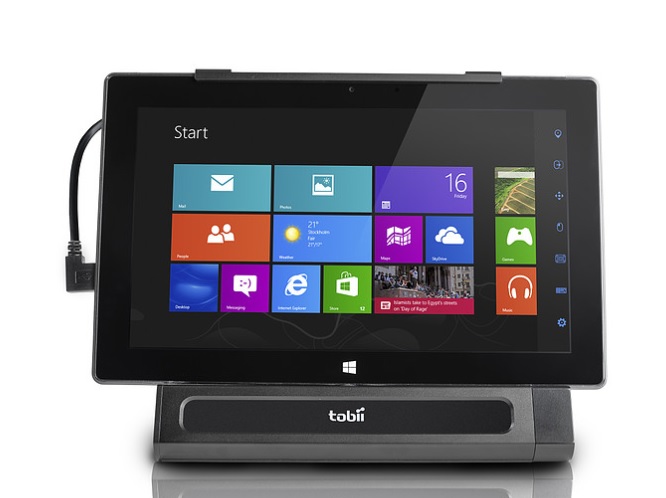Tobii EyeMobile Hands-On: Controlling a Tablet With Your Eyes
Have you ever wondered what it would be like to control a tablet with your eyes? Tobii’s EyeMobile eye-tracker for Windows 8 tablets lets you surf the Web, open apps and more without lifting a finger.
The eye-tracking device is primarily targeted at those with disabilities who don’t have the verbal or physical capabilities to communicate otherwise, but could eventually end up being built into tablets for mainstream use. Similar to Tobii’s Rex eye tracker for PCs, the EyeMobile attaches to Windows 8 tablets to enable hands-free use.
Users can choose to buy the PCEyeGo tracker and accompanying bracket together as a pair ($4,250), separately ($3,900 for PCEyeGo, $350 for the bracket), or packaged with a Microsoft Surface Pro or Dell Latitude 10. The bundle that Tobii demonstrated for us included the PCEyeGo and its bracket, a package that the company refers to as the Tobii EyeMobile.

While the Rex PC peripheral is designed to work in conjunction with a mouse, keyboard or other form of input, the EyeMobile creates an entirely touchless experience. We used the Tobii EyeMobile to navigate the Web and browse through the Windows 8 interface on a Surface Pro after calibrating our eyes with the camera. There’s no user calibration limit, so multiple people can calibrate their eyes to the device at any given time.
The EyeMobile uses a version of Tobii’s Gaze Interaction software optimized for Windows 8 tablets that places a toolbar along the side of the screen. This utility bar features various icons that let you interact with the software in different ways. For instance, staring at a keyboard icon in the menu will pull up a virtual keyboard, while fixing your eyes on the scroll icon will tell the program you want to browse around the screen. There’s a separate icon for clicking, which prevented us from accidentally selecting links or opening apps as we scrolled around websites or the Windows 8 interface.
While this toolbar is designed to help users perform basic tasks using their eyes, a separate menu known as the Windows 8 Overlay lets you use Windows 8-specific features. By selecting this Overlay icon from the sidebar, you’ll pull up a tiled menu that appears over your screen, just like the name implies. From here you can select an icon that will pull up the Charms menu, return you to the Windows 8 Start Screen or close an open app among other capabilities.
MORE: Top 10 Tablets
Stay in the know with Laptop Mag
Get our in-depth reviews, helpful tips, great deals, and the biggest news stories delivered to your inbox.
The eye tracker was responsive overall, but definitely requires a learning curve. It took some time to get used to consistently having to glance over at the main toolbar every time we wanted to click on a link or scroll around the screen. We also had to re-calibrate our eyes multiple times during our demo after the cursor wouldn’t focus in the right area.
The most difficult section of the user interface to control with Gaze Interaction was the virtual keyboard. Since the eye-tracker requires users to look at each letter they want to type, we had to glance quickly from letter to letter to prevent the software from typing the same letter twice. Once we got the hang of this, however, we used our eyes to type the LaptopMag.com URL and browsed our Web page without lifting a finger.
The scrolling tool was the most intuitive and responsive eye-tracking command we saw during the demo. After selecting the scroll icon, we placed the cursor on the top of the screen and looked down to scroll along the page quickly. To move the cursor to another spot, we had to look at the scroll icon again and place it somewhere else on the page.
Overall, the Tobii EyeMobile is an innovative and accurate solution for its target audience. It’s not as fluid and easy to master as the Tobii Rex, but its controls are a little more complex since it caters to those who don’t have touch input as an option. The steep price certainly holds it back from becoming a mainstream hit and the eye-tracker wasn’t responsive in every case, but it works well enough to provide a holistic mobile experience for those who wouldn’t be able to use a tablet otherwise.

